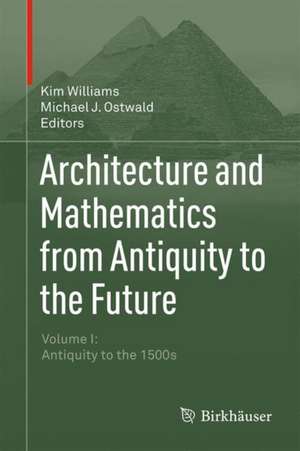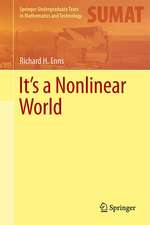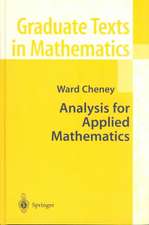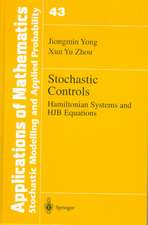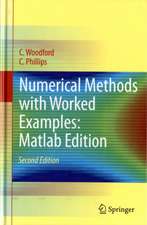Architecture and Mathematics from Antiquity to the Future: Volume I: Antiquity to the 1500s
Editat de Kim Williams, Michael J. Ostwalden Limba Engleză Hardback – 19 feb 2015
Volume I covers architecture from antiquity through Egyptian, Mayan, Greek, Roman, Medieval, Inkan, Gothic and early Renaissance eras and styles. The themes that are covered range from symbolism and proportion to measurement and structural stability. From Europe to Africa, Asia and South America, the chapters span different countries, cultures and practices.
| Toate formatele și edițiile | Preț | Express |
|---|---|---|
| Hardback (2) | 1019.62 lei 6-8 săpt. | |
| Springer International Publishing – 11 mar 2015 | 1019.62 lei 6-8 săpt. | |
| Springer International Publishing – 19 feb 2015 | 1021.69 lei 6-8 săpt. |
Preț: 1021.69 lei
Preț vechi: 1245.96 lei
-18% Nou
Puncte Express: 1533
Preț estimativ în valută:
195.51€ • 205.58$ • 161.54£
195.51€ • 205.58$ • 161.54£
Carte tipărită la comandă
Livrare economică 16-30 aprilie
Preluare comenzi: 021 569.72.76
Specificații
ISBN-13: 9783319001364
ISBN-10: 3319001361
Pagini: 700
Ilustrații: XIX, 735 p. 408 illus., 58 illus. in color.
Dimensiuni: 155 x 235 x 35 mm
Greutate: 1.23 kg
Ediția:2015
Editura: Springer International Publishing
Colecția Birkhäuser
Locul publicării:Cham, Switzerland
ISBN-10: 3319001361
Pagini: 700
Ilustrații: XIX, 735 p. 408 illus., 58 illus. in color.
Dimensiuni: 155 x 235 x 35 mm
Greutate: 1.23 kg
Ediția:2015
Editura: Springer International Publishing
Colecția Birkhäuser
Locul publicării:Cham, Switzerland
Public țintă
ResearchCuprins
Part I: Introduction.- Part II: From 2000 BC to 300AD.- Part III: Theories of Measurement and Structure.- Part IV: From 1100 AD to 1400 AD.- Part V: Theories of Proportion, Symmetry, Periodicity.- Part VI: From 1500 AD to 1600 AD.- Index.- Acknowledgements.
Recenzii
“It presents several alternative historical and theoretical contexts of the relationship between architecture and mathematics which has been pushed to the foreground during the past decades with the increasing use of computer-aided design in their profession … . Historians of mathematics, too, will no doubt find useful material here for their research, especially if they are interested in the more practical concerns that have shaped the development of their field … .” (Yelda Nasifoglu, BSHM Bulletin, Vol. 31 (3), October, 2016)
“The study of connections between mathematics and the arts has grown considerably in recent decades, influenced by the work of Doris Schattschneider, Jay Kappraff, and Michele Emmer, among others. The use of mathematics is particularly a necessity in architecture, so the present set is welcome. … This is a valuable resource for mathematics, architecture, and the arts in general. Summing Up: Highly recommended. All readers.” (C. A. Gorini, Choice, Vol. 53 (2), October, 2015)
“The ambitious goal is to describe both the intimate relation but also the alienation between mathematics and architecture and between mathematicians and architects. … It is an important and highly inspiring collection of papers that will be of interest to researchers from as many disciplines as illustrated by the diversity of the background of the authors. … Highly recommended for readers who do not want to drown or hide in their own abyss of specialization.” (Adhemar Bultheel, euro-math-soc.eu, June, 2015)
“The study of connections between mathematics and the arts has grown considerably in recent decades, influenced by the work of Doris Schattschneider, Jay Kappraff, and Michele Emmer, among others. The use of mathematics is particularly a necessity in architecture, so the present set is welcome. … This is a valuable resource for mathematics, architecture, and the arts in general. Summing Up: Highly recommended. All readers.” (C. A. Gorini, Choice, Vol. 53 (2), October, 2015)
“The ambitious goal is to describe both the intimate relation but also the alienation between mathematics and architecture and between mathematicians and architects. … It is an important and highly inspiring collection of papers that will be of interest to researchers from as many disciplines as illustrated by the diversity of the background of the authors. … Highly recommended for readers who do not want to drown or hide in their own abyss of specialization.” (Adhemar Bultheel, euro-math-soc.eu, June, 2015)
Textul de pe ultima copertă
The aim of this collection of essays is to present a broad portrait of the ways in which two seemingly different disciplines are interconnected. The diversity and varied texture of the essays richly illustrates the affinity between architecture and mathematics. As the almost 100 papers presented in this two-volume publication show, every age and every culture has relied on principles of mathematics incorporated in their works of architecture to imbue their built environment with meaning and order. Included are discussions of geometry, proportional systems, linear algebra, periodic and aperiodic tilings, fractals, perspective, computer science and mechanics. Western architecture of every period is examined: Egyptian, Roman, Medieval, Renaissance, Baroque, Enlightenment, twentieth-century and beyond, as is the architecture of Turkey, China, India, Japan, Australia and Islam. The mathematical nature of the architecture of Leon Battista Alberti, Andrea Palladio and Frank Lloyd Wright is examined, and the philosophical background behind Renaissance architecture is explored. Contributors come from a wide range of disciplines and cultural backgrounds: architects, mathematicians, historians, theoreticians, scientists and educators from the world over. Architecture may be seen and understood in a new light, by professionals as well as non-professionals.
Caracteristici
The most complete anthology addressing a broad panorama of topics regarding relationships between architecture and mathematics Represents the state of the art of multidisciplinary scholarship in architecture and mathematics Sections dealing with specific historical periods are interspersed with sections regarding theory pertinent to those periods Hard-to-find essays collected in a single work Comprehensive introductory essays to both volumes by the editors providing a guide to the discipline Includes supplementary material: sn.pub/extras
